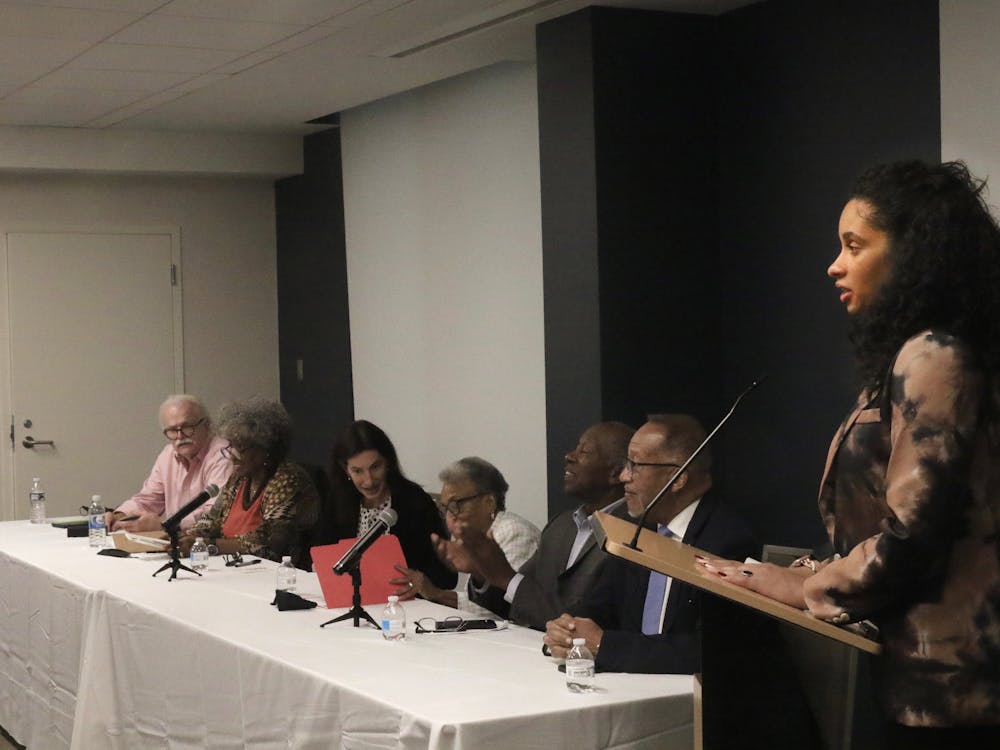On Sept. 14, a few of the original organizers and protesters of Warren County’s environmental justice movement gathered in Penn Pavilion to share their stories in celebration of the 40th anniversary of the influential protest.
Panelists included Dollie Burwell, one of the lead organizers of the protest in Warren County and considered the mother of the environmental justice movement; Congresswoman Eva Clayton, the first Black woman to represent North Carolina in Congress; Reverend Benjamin Chavis, coiner of the term “environmental racism;” Wayne Moseley, a Warren county native who was one of the first to be arrested at the protest; Reverend William Kearney, facilitator of the Warren County Environmental Action Team; and Jenny Labalme, a Duke alumna and student photographer at the protest.
The event was co-sponsored by The Kenan Institute for Ethics, Duke Environmental Law and Policy Clinic, Duke Human Rights Center at the Franklin Humanities Institute, North Carolina Black Alliance and the Warren County Environmental Action Team.
Warren County: Where race and environmentalism intersected
Warren County, North Carolina, was home to a small and predominantly Black community.
In 1978, it was revealed that North Carolina “illegal [disposed] of 31,000 gallons of polychlorinated biphenyl transformer fluid along 240 miles of roadways scattered across 14 counties,” according to “A Road to Walk,” a book written by Labalme chronicling the Warren County protests. PCB was a known carcinogen, and in 1978 some levels were “200 times above the contamination level set at the time by the Environmental Protection Agency.”
Warren County was the location designated by North Carolina state officials for the disposal of the industrial waste infused with toxic PCB into landfills. These PCBs, disposed of illegally along North Carolina roadways, seeped into and contaminated local water supply, proving to be a local environmental and health hazard.
As residents of Warren County became aware of the environmental hazard of the PCB landfill and the health hazards for the community, they began organizing.
The community first attempted to stop the actions of the state through legal proceedings, but numerous lawsuits failed, according to Labalme in “A Road to Walk.”
In September 1982, “the community turned to protest and civil disobedience with a lot of ire aimed at North Carolina Gov. James B. Hunt. It was the first time nationwide that anyone was arrested and jailed for protesting dump trucks hauling toxic-laced dirt,” per Labalme.
The landfill detoxification process took five years and was completed in 2003.
Forty years later, and the stories are still vivid
Moseley recounted the morning of his first arrest as a part of the marches.
“We met at Coley Springs Baptist Church, around 9 in the morning, it was a beautiful day, we were singing lyrics barred from the civil rights movement of the 60s,” said Moseley. “As we approached the site, we were met by about 75 or more highway patrol, who were dressed in full riot gear.”
“Sixty-six of us chose to sit in the roadway to block the trucks and were arrested that first day,” Moseley added.
Labalme recalled the protests from her unique perspective as a 22-year-old Duke student photographer reporting on the PCB protests.
“I was so moved by what I saw: the grit, the determination, the outrage, and the sense of injustice of a landfill that didn't even meet EPA standards at the time being placed in a predominantly Black community,” said Labalme. She described the moment as profoundly impacting her early journalistic career.
Chavis described how Warren County represents how individuals can collectively stand up against a racist system.
“We are hoping that we can change the narrative from being a victim to being a part of this larger force for racial, environmental and social justice,” said Chavis.
The lasting impact of Warren County
Get The Chronicle straight to your inbox
Sign up for our weekly newsletter. Cancel at any time.
Clayton emphasized the importance of the Warren County protests in the spread of a larger environmental justice movement in other affected minority-heavy communities.
“What we did in Warren County was symbolic to what was happening throughout. No longer was it a Warren County protest. It became a nation’s protest,” said Clayton.
Kearney reiterated the persistence of environmental injustice and the consequent importance of the matter that remains in today’s society.
“Forty years later what started there in Warren County is now all over the world. It is a global environmental justice movement,” Kearney said.
Correction: A previous version of this article misspelled Reverend Benjamin Chavis, Wayne Moseley and Jenny Labalme's last names as Chavez, Mosley and Lablame respectively. The Chronicle regrets the error.

